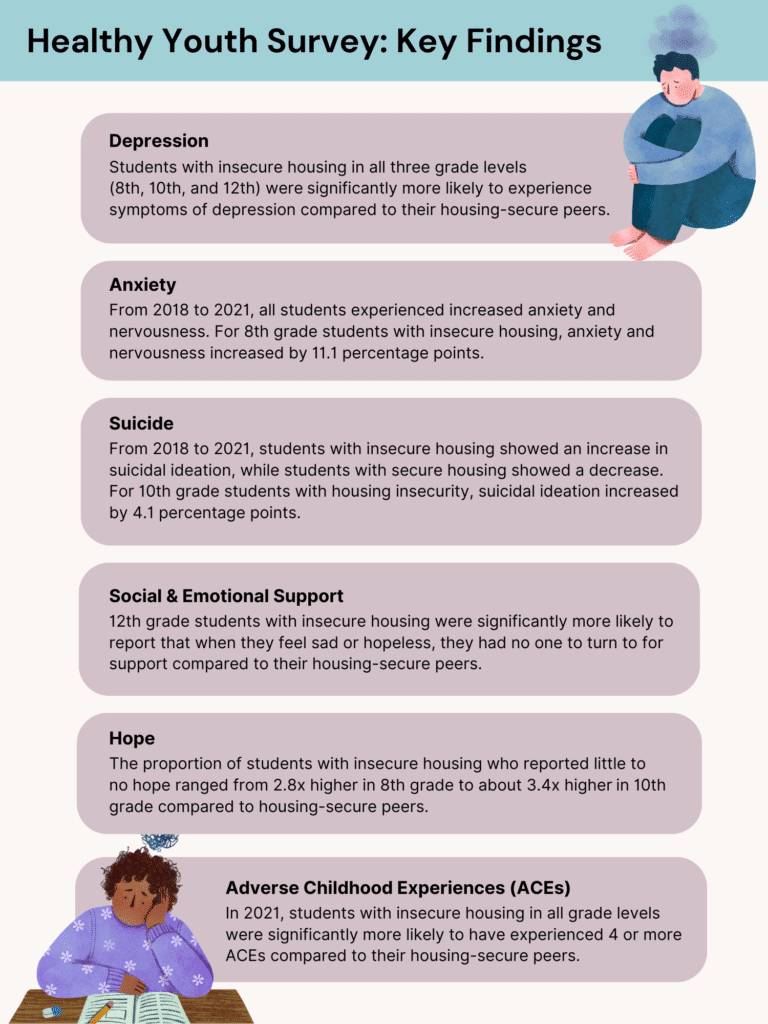The first time Ava* experienced a panic attack at school, she was in kindergarten. It was recess and while other kids were playing kickball and climbing the monkey bars, Ava was standing off to the side. She remembers the clammy hands, the racing heart, the fear of impending doom. Little did Ava know this would be a common occurrence throughout her life, happening in high school and college.
Throughout childhood, Ava thought she was the only one that experienced panic attacks because no one really talked about anxiety. She thought something was wrong with her. Ava didn’t have any hope her anxiety would go away. It was only in adulthood that she truly realized she was not alone, and she did have control over her anxiety.
Ava’s experience reminds us that mental health impacts everyone, including children. Studies show that the pandemic has negatively impacted children’s mental health,1 and students who experience homelessness have greater mental health needs.2
Our state tracks the mental health experiences of students through the Healthy Youth Survey (HYS), which is administered every two years to Washington students in grades 6, 8, 10, and 12. It asks students their thoughts, feelings, and behaviors on a variety of health and safety topics.
According to a new analysis of Healthy Youth Survey data by Building Changes, in 2021, a total of 169 schools and 31,167 students contributed to the statewide HYS results. Importantly, the HYS asked a question around living situation in grades 8, 10, and 12, in which students can self-report if they were living in insecure housing situations. Of the students that responded, who are representative of students in Grades 8, 10, and 12 across the state, 2.6%, 2.7%, and 3.3%, respectively, reported that they were experiencing insecure housing. These rates are lower than those reported in previous years by HYS.
Unfortunately, the available data does not allow us to disaggregate by both race/ethnicity and housing status to determine combined impacts on mental health for students. Based on our research using OSPI data, we know that students of color are disproportionately represented in the student homeless population—6 out of 10 students experiencing homelessness are students of color. Institutional racism, which exists in our housing and education systems, also causes trauma and can lead to negative mental health outcomes.
Here are key findings from the most recent Healthy Youth Surveys for students experiencing housing insecurity:
Our upcoming legislative advocacy work
Homelessness has long been associated with negative mental health outcomes for children.3 At Building Changes, we know that the education, mental health, and housing systems need to work more closely together to better serve children, youth, and families experiencing homelessness. In the 2023 state legislative session, Building Changes will advocate for a $5.6 million increase in funding for the Homeless Student Stability Program (HSSP), which awards grants statewide to school districts and nonprofits. HSSP encourages school districts and nonprofit partners to work together, and the program has successfully improved educational outcomes for students experiencing homelessness by providing housing and education supports to students.
An additional $5.6 million would increase the number of grants and expand the reach of HSSP across the state. HSSP can be used to help address students’ mental health by:
- Increasing mental health supports in schools
- Increasing resources for students experiencing homelessness across the state, including in rural areas
- Increasing collaboration between schools and community-based organizations
- Increasing housing stability for students experiencing homelessness
Building Changes will also be supporting our advocacy partners’ legislative items focused on children’s mental health outcomes. This includes the two state advisory groups that we are members of which focus on behavioral health needs of students and the prenatal to 5 populations. We encourage everyone to learn more about the issues affecting students experiencing homelessness, elevate these in your community, and share them with your legislators.
* Pseudonym used to protect identity of person sharing story. Story used with permission.
1 Naff, D., Williams, S., Furman-Darby, J., & Yeung, M. (2022). The Mental Health Impacts of COVID-19 on PK–12 Students: A Systematic Review of Emerging Literature. AERA Open, 8.
2 Shah, M., Black, C., & Felver, B. (2015). Homeless and Unstably Housed K-12 Students in Washington State: Who are they and how are they faring? Washington Department of Social and Health Services, Research and Data Analysis Division, No 11.214.
3 The National Child Traumatic Stress Network, Facts on Trauma and Homeless Children. (2005).


